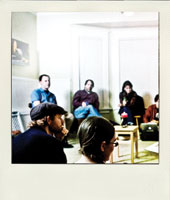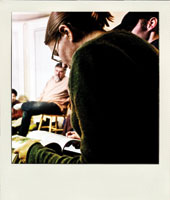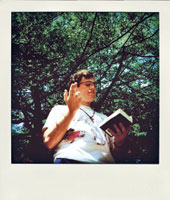Readers of a Lost Art
Eighteen years later, the Thomas Parker Society still has an excuse to be together
Eric Morgan ’94 had been murdered.
When the news was read aloud to a hushed circle of Morgan’s friends, well … none of us who were present will ever forget that moment.
Nor will we forget our response to this tragic news: laughter.
Somewhere in South Africa, Eric Morgan was laughing, too. His death, you see,
was fictional.
The real Eric Morgan did not wash up on the beach of Seattle Pacific University’s Camp Casey Conference Center in the summer of 1991. But the make-believe Eric Morgan, a character in a murder mystery about the SPU students working at Camp Casey, was discovered among driftwood and seaweed on the pages of the story.
For a few weeks that summer, Morgan had worked among classmates and friends as a camp counselor for kids before he left to spend the rest of the summer working with a mission team in South Africa. When he left, the rest of us who were employed
as groundskeepers, housekeepers, and camp counselors used his “disappearance” as the inspiration for a serial murder mystery. Morgan was judged “expendable,” and the rest of us immediately became suspects.
The Summer of Love …
for Literature and Friends

At a 2009 gathering of the Thomas Parker Society, Julie Mullins reads from The Wild Braid by Stanley Kunitz. Photo by Luke Rutan |
Looking Twice: The Camp Casey Murder Mystery became just one of many creative collaborations during our three months of hard work and harder play in those idyllic surroundings on the coast of Whidbey Island. Everybody brainstormed, while I put the story down on paper.
Every Wednesday night at 8:45 p.m., we put our daytime tasks behind us, took up flashlights, and ventured into the woods that waited on the north end of Camp Casey’s green soccer fields.
A short while later, we arrived at an old cement bunker (or battery), one of the northernmost installments of the historic Fort Casey. Camp Counselor Wayne Proctor ’92 opened the bunker’s heavy iron door and welcomed us. We paraded down the cobwebbed corridor to a cement room, where we formed a quiet circle around a solitary candle.
Each participant then took a turn reading aloud by flashlight. Poetry. Scripture. Excerpts from classic novels. Shakespearean soliloquies. Anything.
Me? I read those weekly murder-mystery chapters, revealing to everyone the next part of the story. The chapters were stuffed with details of all we saw and experienced that summer: foxes, mosquitoes, owls, odd souvenirs found in the forest, the tidal wave of fog that engulfed the camp each morning, the progress of growing relationships, and, yes, romances. Anecdotes, ideas, and in-jokes congealed into zany comedy capers.
An etching on the wall informed us that Lieutenant Thomas Parker, the bunker’s namesake, had been killed in 1861. So we called ourselves The Thomas Parker Society.
These gatherings required few resources, and cost us nothing more than a couple of hours a week — a small price for such tremendous rewards as lasting friendships, new literary discoveries, and unforgettable aesthetic experiences.
During that summer’s last Thomas Parker gathering, I read the final scene of the mystery to the attentive circle. Meanwhile, coworker Bryan Karsh ‘95 crept outside the bunker. He draped himself in a white sheet and made a dramatic, startling entrance as the Ghost of Thomas Parker. I saw goosebumps all around the circle. Karsh proceeded to recite a memorized speech that revealed Eric Morgan’s “killer” to us all. Then the ghost vanished to an enthusiastic ovation.
A few of our secretive readings proved even wilder than that. The most disturbing? One brave person read out the ingredients from the crinkling wrapper of a Hostess Twinkie. But it wasn’t all frivolity. Many of those readings — Kipling, Dahl, Shakespeare, Tolkien, Dickinson — were immersive, inspiring experiences. “My favorite memories are of how the Thomas Parker Society transported all of us Casey workers away to distant places and times and adventures,” says Scott Kassner ’92.
The poet Jane Hirshfield writes, “Saying a poem aloud ... our bodies as well as our minds enter the rhythms present at the poem’s conception. We breathe as the author breathed, we move our own tongue and teeth and throat in the ways they moved in the poem’s first making. There is a startling intimacy to this. Some echo of a writer’s physical experience comes into us when we read her poem … .”
We all experienced that kind of intimacy in those hours of simple listening. It was the genesis of something special: a community that would bring encouragement, support, and escape for decades to come.
Art and Soul

“These gatherings cost us nothing more than a couple of hours a week.” |
“The idea for the Society was sort of in the air that summer,” says Proctor. “The movie Dead Poets Society was very popular. But it also came about because this unique group wanted to hang out all the time. We just kept looking for excuses to be together.”
Eighteen years after that summer at Camp Casey, Proctor and I are sitting at a café in North Seattle planning the next few Thomas Parker gatherings. We still use those excuses — art and imagination — to assemble with friends old and new.
In 1992, we spread blankets on the grass of SPU’s Tiffany Loop. We’ve hosted the readings in the homes of members around Seattle. We’ve read aloud through sunsets on Alki Beach. We’ve gathered in a gazebo at the University of Washington’s Arboretum. Some of us assemble in July on the campus of St. John’s College in Santa Fe, New Mexico. In 1995, the group drew the attention of a Queen Anne News reporter, who composed a full-page feature titled “Queen Anne’s Dead Poets Society.”
We’ve heard early drafts of novels and poems that went on to publication. We’ve journeyed through Narnia, played a guessing game called “Water in the Face,” and even witnessed a performance art video that involved white feathers and fake blood. Margaret Smith ’80 has dazzled us with performances of Celtic ballads. We’ve even been visited by acclaimed novelists Robert Clark, Brett Lott, and Sara Zarr, and SPU Professor of Art Laura Lasworth.
“Mark Helprin’s Winter’s Tale, Jane Hirshfield’s The Lives of The Heart, Michael Chabon’s Summerland, Shaun Tan’s The Red Tree … some of the raw materials presented have become as dear to me as the readers,” says Seattle musician Bryan Rust. He’s contributed, too, performing his own songs and sharing another unusual art: stereo photography.
Danny Walter ’94, a founding member and a former SPU theatre major, has watched some of his short plays performed on Seattle stages. He tried them out first on The Thomas Parker group. “I can always count on Thomas Parker to raise my spirits whether I am up or down,” he says. “The stories we read to the group, in some little way, always reveal a bit about ourselves.”
Looking back, I wonder what would have been different if we’d all had cell phones and the Internet. Would we have started the Society if we’d all been wired to the outside world instead of learning to live together and enjoy one another? Is the art of reading aloud in community becoming a lost art?
Whatever the case, new technologies give the Society new options. Invitations go out through Facebook. And Walter, having recently moved to L.A., has visited the group through Google Video Chat.
More Than a “Book Club”

Wayne Proctor reads from The Selected Poetry of Rainer Maria Rilke in Tiffany Loop in the summer of 1992. |
According to Proctor, The Thomas Parker Society is better than your average “book club” because of its camaraderie, spontaneity, and a round-table approach that gives participants equal opportunity. And, of course, most book clubs don’t last for nearly two decades.
“It’s funny,” says Proctor. “First-timers tend be nervous, asking if it’s formal or if there are rules. But the Society has remained remarkably free and spontaneous.
Gathering to celebrate beauty, excellence, and creative expression, we’ve learned so much about each other, and we support one another in a much bigger endeavor: the rest of our lives.
I remember finding comfort and healing in the society’s company during a year of heartbreak and loss. Several members have suffered through periods of unemployment, illness, and personal tragedy, finding encouragement in this community. One young woman read a heartbreakingly candid account from her journals, detailing the trials of breast cancer. Another cancer patient invited her husband, just home from service in Afghanistan, and he read from a military manual about how not to use a hand grenade. Eric Morgan ’93 and Afarin Tehrani Morgan ’93, both members of the original society, got married. I met my wife, Anne, at a Society meeting more than 14 years ago.
As the group has grown, it has welcomed people of other faiths, other passions. By focusing on creative expression, the Society creates a context in which penetrating conversations can occur on controversial subjects without the discomfort of direct debate or confrontation.
Despite the diversity, the Society has never lost that sense of the sacred in art and community, and meetings often close with a prayer sung in Latin — the same chorus that once echoed through the bunker. It’s given us a sense of strength in numbers, a kind of family in which everyone has something valuable to share, and no one is expendable.
Not even Eric Morgan.
Return to top
Back to Features Home
|